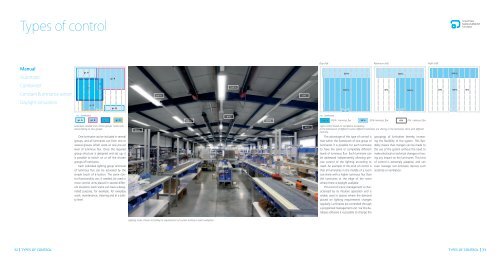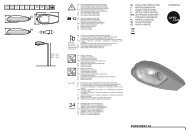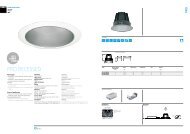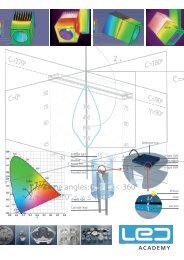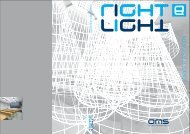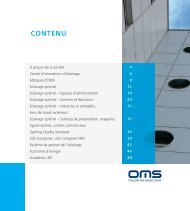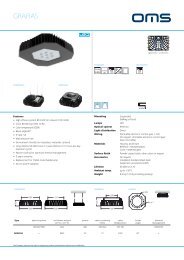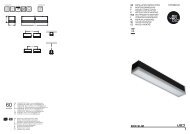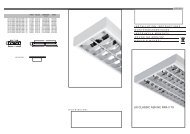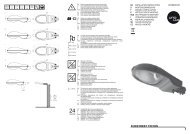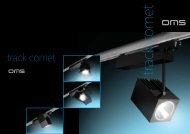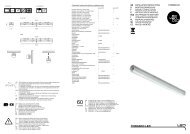Lighting MAnAgEMEnt SYStEM - OMS lighting
Lighting MAnAgEMEnt SYStEM - OMS lighting
Lighting MAnAgEMEnt SYStEM - OMS lighting
Create successful ePaper yourself
Turn your PDF publications into a flip-book with our unique Google optimized e-Paper software.
Types of control<br />
Manual<br />
Automatic<br />
gr. A<br />
gr. B<br />
Day shift<br />
50 %<br />
Afternoon shift<br />
50 %<br />
Night shift<br />
100 %<br />
Combined<br />
Constant illuminance sensor<br />
gr. C<br />
100 %<br />
100 %<br />
0 %<br />
100 %<br />
0 %<br />
100 %<br />
0 % 50 % 0 %<br />
Daylight simulation<br />
gr. D<br />
gr. A<br />
luminaires<br />
gr. A gr. B gr. C gr. D<br />
100 %<br />
0 %<br />
50 %<br />
luminaires<br />
100 % 100 % luminous flux 50 % 50 % luminous flux 0 % 0 % luminous flux<br />
Luminaires divided into control groups. Some luminaires<br />
belong to two groups.<br />
50 %<br />
50 %<br />
Light control based on workplace occupancy.<br />
In the framework of different scenes different luminaires are shining or the luminaires shine with different<br />
intensity.<br />
One luminaire can be included in several<br />
groups, and all luminaires can form one or<br />
several groups which work at one pre-set<br />
level of luminous flux. Once the required<br />
group structure is designed and set up, it<br />
is possible to switch on or off the chosen<br />
groups of luminaires.<br />
Each individual <strong>lighting</strong> group and level<br />
of luminous flux can be activated by the<br />
simple touch of a button. The same control<br />
functionality can, if needed, be used in<br />
more control units placed in several different<br />
locations. Each scene can have a designated<br />
purpose, for example, for everyday<br />
work, maintenance, cleaning and at a safety<br />
level.<br />
The advantage of this type of control is<br />
that within the framework of one group of<br />
luminaires it is possible for each luminaire<br />
to have the same or completely different<br />
levels of luminous flux. Each luminaire can<br />
be addressed independently allowing precise<br />
control of the <strong>lighting</strong> according to<br />
need. An example of this kind of control is<br />
that all luminaires in the middle of a room<br />
can shine with a higher luminous flux than<br />
the luminaires at the edge of the room<br />
where there is daylight available.<br />
This kind of scenic management is characterised<br />
by its intuitive operation and is<br />
widely used in spaces where the demand<br />
placed on <strong>lighting</strong> requirements changes<br />
regularly. Luminaires are controlled through<br />
a programed management unit. Via this database<br />
software it is possible to change the<br />
groupings of luminaires thereby increasing<br />
the flexibility of the system. This flexibility<br />
means that changes can be made to<br />
the use of the system without the need to<br />
make electrical or technical changes or having<br />
any impact on the luminaires. This kind<br />
of control is extremely adaptive, and can<br />
even manage non-luminaire devices such<br />
as blinds or ventilation.<br />
<strong>Lighting</strong> scene chosen according to requirements of current activity in each workplace.<br />
32 I TYPes of control<br />
TYPes of control I 33


